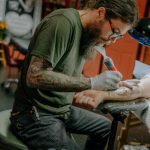You know that feeling when you catch a glimpse of your old tattoo in the mirror and cringe just a little? Maybe it was that impulse decision at 18 to get a tattoo in Dallas, or perhaps the artist didn’t quite capture what you had in mind. The good news is that regrettable ink doesn’t have to be permanent anymore. Welcome to the world of cover-up artistry, where skilled tattoo artists transform yesterday’s mistakes into tomorrow’s masterpieces.
The Art of Second Chances
Cover-up tattoos represent one of the most challenging and rewarding aspects of tattooing. Unlike working on fresh skin, artists must navigate existing pigments, scar tissue, and design limitations while creating something entirely new and beautiful. It’s part artistic vision, part technical wizardry, and part psychological healing.
Think of it as artistic archaeology. Your tattoo artist becomes both demolition expert and renaissance painter, carefully working with what exists while building something spectacular on top. The process requires patience, creativity, and a deep understanding of how different pigments interact with each other over time.
Can You Cover Up Tattoos with Other Tattoos?
Absolutely, you can cover up tattoos with other tattoos. This is the fundamental principle behind cover-up artistry. However, it’s not as simple as just tattooing over the old design. The existing tattoo becomes part of the canvas, influencing color choices, design elements, and overall composition.
The key lies in understanding color theory and ink interaction. Darker colors can effectively mask lighter ones, but you can’t simply put yellow over black and expect it to show up yellow. Your artist must work strategically, often incorporating the existing tattoo’s darkest elements into shadow work or using them as foundation layers for deeper, richer colors.
Some cover-ups require laser lightening sessions before the new tattoo work begins. This hybrid approach has revolutionized the field, allowing artists to tackle previously impossible projects.
Technical Challenges That Make Artists Sweat
Cover-up work presents unique technical hurdles that separate the masters from the novices. First, there’s the color challenge. You’re essentially painting with a limited palette because you can only go darker or match the existing tones. Light colors become nearly impossible unless you’re working around them cleverly.
Scar tissue adds another layer of complexity. Old tattoos, especially those that were heavy-handed or poorly healed, create textural changes in the skin. The needle behaves differently on scar tissue, ink doesn’t always settle evenly, and healing can be unpredictable.
Then there’s the composition puzzle. Your artist must create a cohesive design that not only covers the unwanted tattoo but also flows naturally with your body’s contours. Sometimes this means going bigger than originally planned. Sometimes it means getting creative with negative space.
The existing tattoo’s age matters too. Fresh tattoos are actually harder to cover because the pigments are more vibrant and haven’t had time to fade. Older tattoos, while potentially more faded, might have spread under the skin, creating blurry edges that complicate precise line work.
Artistic Problem-Solving at Its Finest
Every cover-up project is essentially a puzzle that requires creative problem-solving. Your artist becomes part detective, part magician, examining the old tattoo from every angle to determine the best approach.
Consider the classic scenario: covering up an ex’s name. Simple black script might seem easy to tackle, but the artist must consider letter spacing, ink density, and how to incorporate those shapes into something entirely different. Maybe those letters become part of a tree’s bark texture, or they disappear into the shadows of a dramatic portrait.
Geometric tattoos present their own challenges. Those crisp lines and precise angles don’t easily transform into organic shapes. But skilled artists can work these elements into architectural backgrounds, incorporate them into mandala designs, or use them as structural elements in larger compositions.
Color corrections require particular finesse. That muddy green from a poorly executed piece might become the perfect undertone for a forest scene. Purple that’s gone too blue could be the ideal base for a dramatic sunset. It’s about seeing potential where others see problems.
The Multi-Session Marathon
Forget about getting your cover-up done in a single sitting. Quality cover-up work typically requires multiple sessions, sometimes spanning months or even years for complex pieces.
Session one often focuses on establishing the foundation. Your artist might begin with the darkest elements, using them to neutralize the most problematic areas of the original tattoo. This session is about strategy more than beauty – don’t expect Instagram-worthy results yet.
The healing period between sessions is crucial. Your artist needs to see how your skin responds to the new work, how colors settle, and whether any touch-ups are needed before moving forward. Rushing this process almost always leads to compromise in the final result.
Session two typically involves building up the main elements of the design. This is where you start seeing the transformation take shape. Colors become more vibrant, details emerge, and the original tattoo begins its disappearing act.
Subsequent sessions focus on refinement. Adding highlights, perfecting color gradations, and ensuring every element works harmoniously together. Some cover-ups require four or five sessions to achieve perfection.
Working with Your Artist’s Vision
Your role in a cover-up transformation extends beyond simply showing up to appointments. This is a collaborative process that requires trust, patience, and realistic expectations. The relationship you build with your artist during this journey can make the difference between a good result and an extraordinary one.
Come prepared with reference images, but remain open to your artist’s suggestions. They understand the technical limitations better than anyone and might propose solutions you never considered. That geometric mandala you had in mind might not be feasible, but they might suggest a biomechanical design that incorporates those angular elements beautifully.
Consultation is everything. During your initial meeting, be completely honest about what you hate about your current tattoo and what you hope to achieve. Don’t hold back details because you think they might complicate things – complications are exactly what your artist needs to know about. The more information they have, the better they can strategize.
Expect your artist to ask probing questions. How does the tattoo feel under pressure? Has it ever been touched up or reworked? What’s your pain tolerance like? These aren’t idle curiosities – they’re gathering intelligence that will inform every decision moving forward.
Be prepared for reality checks. Your Pinterest board full of delicate watercolor designs might not be compatible with covering up that solid black tribal piece from 2003. A skilled artist won’t just tell you no; they’ll explain why and offer alternatives that achieve similar aesthetic goals while working with your existing canvas.
The design process itself becomes a negotiation between your vision and physical reality. You might start discussing a small floral piece and end up planning a full sleeve because that’s what’s needed to properly address the coverage area. This isn’t upselling – it’s problem-solving.
Timeline discussions are crucial. You might be eager to fix your tattoo regret immediately, but your artist might recommend waiting. Fresh tattoos need time to settle before they can be effectively covered. Rushing this timeline often results in muddy colors and uneven coverage.
The Psychology of Transformation
Cover-up tattoos offer more than aesthetic improvement – they provide psychological healing. There’s something profoundly liberating about transforming a source of daily regret into something you’re proud to display.
Many clients describe the process as cathartic. You’re not just covering up old ink; you’re reclaiming that part of your body and rewriting its story. The new tattoo becomes a symbol of growth, change, and the courage to fix what isn’t working.
Maintenance and Long-term Care
Your cover-up transformation doesn’t end when the final session heals. These tattoos often require more diligent aftercare and may need touch-ups over time, especially if the underlying tattoo was particularly dark or complex.
Sun protection becomes even more critical with cover-ups. UV exposure can cause differential fading between the old and new inks, potentially revealing elements you thought were permanently hidden.
Regular moisturizing helps maintain color vibrancy and keeps the skin healthy. Some artists recommend specific products for cover-up work, particularly during the healing phases.
Embracing Your Renaissance
The transformation from regret to renaissance isn’t always linear. Some days during the multi-session process, you might feel worse about your tattoo than when you started. This is normal and temporary.
Trust the process. Your artist has guided others through similar journeys and understands the emotional ups and downs involved. That awkward in-between phase will pass, replaced by something you never imagined possible when you first walked into the shop.
The final reveal moment – when you see your completed cover-up for the first time – is often described as magical. Clients frequently say they forget the original tattoo was ever there. The new piece doesn’t just hide the old one; it completely transforms the narrative of that space on your body.
Your cover-up journey represents more than just getting new ink. It’s about second chances, artistic collaboration, and the beautiful possibility that our mistakes don’t have to define us. In the hands of a skilled artist, your biggest tattoo regret can become your favorite piece of body art.
The renaissance is waiting. All you need is the courage to begin.


